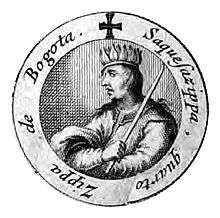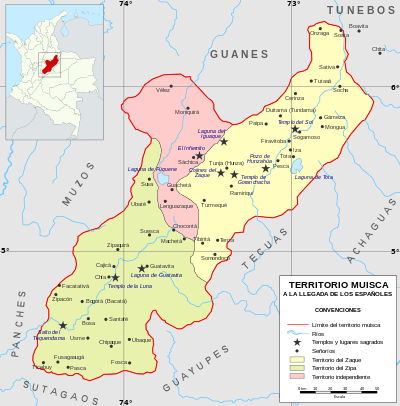Sagipa
| Sagipa | |
|---|---|
| zipa | |
 Sagipa, the last ruler of Bacatá, depicted in 1688 | |
| Reign | 1537–1539 |
| Predecessor | Tisquesusa |
| Successor | Position abolished |
| Born |
unknown Muisca Confederation |
| Died |
1539 Bosa, New Kingdom of Granada |
| Chibcha | Zaquesazipa |
| Dynasty | Bacatá |

Zipa reign in green
Sagipa or Zaquesazipa (died Bosa, 1539) was the fifth and last ruler (zipa) of Bacatá, currently known as the Colombian capital Bogotá, as of 1537. He was the brother of his predecessor Tisquesusa but the traditional faction of the Muisca considered him an usurper as his nephew Chiayzaque, the cacique of Chía, was the legitimate successor of Tisquesusa. His zaque counterpart in the northern part of the Muisca territory was Aquiminzaque, the last surviving ruler of the Muisca.
Sagipa appears with alternative names in the Spanish chronicles; Saquesazippa, Saquezazippa, Sacresasigua, Saxagipa, Sajipa and Zaquezazigua.[1][2]
Biography
Before the arrival of the Spanish conquistadors in the central highlands of present day Colombia, the area was populated by the Muisca, ruled by the zipa; southern part, capital Bacatá and zaque; northern part, capital Hunza.
Sagipa was a general in the army of the third and fourth rulers of the southern Muisca, Nemequene and Tisquesusa respectively. In this role Sagipa fought against the zaque Quemuenchatocha. With the arrival of the Spanish in the central Colombian highlands in 1537, the northern and southern Muisca rulers conspired against the common enemy. The ruler of the northern Muisca, Quemuenchatocha, tried to buy off the Spanish with gifts. When Sagipa's brother Tisquesusa was killed by the Spanish conquerors, Sagipa took over the rule. According to the Muisca tradition the nephew of both Sagipa and Tisquesusa, the cacique of Chía, should have accessed the throne. This Chiayzaque was loyal to the Spanish and Sagipa wanted to avenge the death of his brother. The caciques Cuxinimpaba and Cuxinimegua repudiated Sagipa.[2]
The constant attacks by Sagipa and his people drove the Spanish out of the then drassy intermontane flatlands of the Bogotá savanna towards Bosa, now part of the Colombian capital. When the Panche were revolting against the new rulers in Zipacón, Sagipa took up peace negotiations with the leader of the Spanish troops, Gonzalo Jiménez de Quesada pointing to the risk for both the Muisca and the Spanish of destroyed crops by the Panche. De Quesada with only 50 soldiers and Sagipa 12,000[3] to 20,000[4] guecha warriors strong beat the Panche on 20 August 1538 in the Battle of Tocarema and celebrated the victory.
Sagipa was held by the new Spanish rulers on accusation of his illegal rule. The Spanish demanded the vast amounts of gold of the heritage of Tisquesusa. Initially Sagipa denied and went into hiding. When Sagipa saw the Muisca lost faith in his rule he surrendered to De Quesada. Outraged by his refusal to hand over the treasure Sagipa was tortured with iron bars. In early 1539 the last zipa died in the Spanish camp in Bosa as a result of the torments by the Spanish rulers.[5][6][7]
See also
References
- ↑ Matiz, 1801
- 1 2 Ocampo López, 2004, p.176
- ↑ (Spanish) Battle of Tocarema - Universidad de los Andes
- ↑ Groot, José Manuel. 1869. Historia eclesiástica y civil de Nueva Granada - Tomo I. Imprenta de Focion Mantilla.
- ↑ (Spanish) Biography of Sagipa - Banco de la República
- ↑ (Spanish) Zipa Sagipa - Pueblos Originarios
- ↑ (Spanish) History of Sagipa - Universidad Distrital Francisco José de Caldas
Bibliography
- Matiz, Samper. 1801. República de Colombia: historia general de los Chibchas, 1-103. Accessed 2016-10-05.
- Ocampo López, Javier. 2004. Tesoros legendarios de Colombia y el mundo, 1-351. Accessed 2016-10-05.